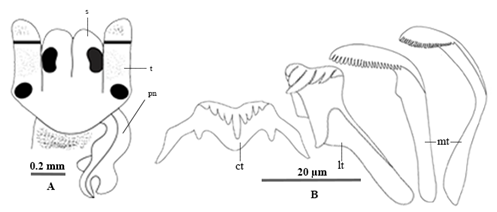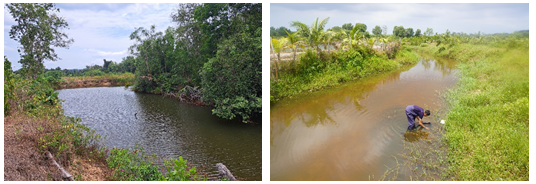NEW RECORD OF Clenchiella victoriae Abbott, 1948 (Gastropoda, Littorinimorpha, Clenchiellidae) FROM VIETNAM
Southern Branch of the Joint Vietnam - Russia Tropical Science and Technology Research Center
No.3, 3/2 street, ward 11, district 10, Ho Chi Minh City, Vietnam
Main Article Content
Abstract
Genus Clenchiella including six species, is mainly distributed in mangrove swamps or estuarine areas. To date, only Clenchiella minutissima (Wattebled, 1884) has been recorded in Vietnam water. Our paper is the first report Clenchiella victoriae Abbott, 1948 from Vietnam based on 12 specimens collected in Phu Quoc islands in March 2024. C. victoriae is characterized by having a pronounced keel on the mid-dorsal and mid-ventral shell, penis always located behind the right cephalic tentacle, and contains two distally glandular lobes.
Keywords
Clenchiella victoriae, islands, new record, Phu Quoc, đảo, ghi nhận mới, Phú Quốc
Article Details
1. INTRODUCTION
Genus Clenchiellawas described by Abbott from the Philippines in 1948 with the holotype as Clenchiella victoriae Abbott, 1948 (Gastropoda, Littorinimorpha, Clenchiellidae) [1]. Clenchiella is characterized by having a prominent carina or keel on the mid-dorsal and mid-ventral shell, robust apertural varix on the outside, a black pigment band situated on each head tentacle, and the penis containing some unique distal lobes [2]. Up to date, six species, mainly distributed in mangrove swamps or estuarine areas, were described for the genus Clenchiella comprising C. minutissima (Wattebled, 1884) distributed in Australia, Singapore, Papua New Guinea, Thailand, and Vietnam; C. victoriae Abbott, 1948 and C. abatanriver Rubio & Rolán, 2020 found in the Philippines; C. bicingulata Ponder, H. Fukuda & Hallan, 2014 explored in Singapore; C. varicosa Ponder, H. Fukuda & Hallan, 2014 collected in Hongkong and Taiwan; and C. iriomotensis Ponder, H. Fukuda & Hallan, 2014 discovered in Japan [1, 2, 3, 4]. In Vietnam, there is poorly known about Clenchiellidae except for C. minutissima (Original name: Valvata minutissima) described by Wattebled in 1884 with a type locality in Long Xuyen, An Giang province (“L’arroyo de Long-Xuyen”) [5]. During our expedition in March 2024 on Phu Quoc islands, numerous minute specimens of Clenchiella were collected. In this paper, we report for the first time the occurrence of C. victoriae Abbott, 1948 in Phu Quoc islands, Southern Vietnam. The morphological description of this species is provided.
2. MATERIALS AND METHODS
In the field, specimens for the study were collected by using the D-frame net with a mesh size of 500 µm along the riverbank of Cua Can and Cua Lap rivers in Phu Quoc islands between 14 and 18 March 2024 (Figure 1). Collected specimens were quickly fixed with 99% ethanol solution. In total, twelve collected specimens were used to examine and measure morphology.
In the laboratory, each specimen was cleaned with distilled water and dissected by an Optica SZM-LEDZ microscope with the connecting C-HP HDMI Optica camera. Specimens were identified based on morphological and anatomical comparisons using appropriate monographs of Abbott (1948), and Ponder et al. (2014) [1, 2]. The main features used for species identification comprised teleoconch morphology and characteristics of the penis. After being examined, all specimens were stored in the Departure of Aquatic Ecology, Southern Branch of the Joint Vietnam - Russia Tropical Science and Technology Research Center.

Figure 1. Survey area
3. RESULTS AND DISCUSSIONS
Systematic accounts
Class Gastropoda Cuvier, 1797 [6]
Order Littorinimorpha Golikov & Starobogatov, 1975 [7]
Family Clenchiellidae D. W. Taylor, 1966 [8]
Genus Clenchiella Abbott, 1948 [1]
Clenchiella victoriae Abbott, 1948 (Fig. 2, 3)
Clenchiella victoriae Abbott, 1948: 76-79, Plate 5, Figures 1-7 [Type locality: San Joaquin river, Philippines]; Ponder, Fukuda & Hallan, 2014: 111-114, Figure 1.
Material examined: 12 individuals comprising 7 specimens collected at Cua Can river, 10°18'01.8"N 103°56'35.1"E, and 5 specimens at Cua Lap river, 10°10'33.0"N 103°58'58.0"E.
Description: Shell small to very small range from 1.58 to 1.84 mm in diameter and from 0.68 to 0.86 mm in height (Table 1); shell solid, planispiral or discoidal forms, spire flat with protoconch not prominent above spire. Shell of approximately 4 - 4.5 whorls comprising 1.5 whorls of protoconch and 2.5 - 3 whorls of the teleoconch. Teleoconch close to round, sculptured with fine and regular spiral lines, apart from a strongly and angularly pronounced carina or keel in the mid-dorsal and mid-ventral shell. Shell white, covered with moderately thickened and light reddish brown periostracum (Figure 2).

Figure 2. Clenchiella victoriae Abbott, 1948; A. Dorsal shell view; B. Apical shell view; C. Ventral shell view; D. Internal operculum view; E. External operculum view
Umbilicus very wide and deep, ranging from 0.54 to 0.69 mm in width. Sutures somewhat impressed. Aperture near round or circular, prosoline form, with its height of 0.52 to 0.64 mm (Table 1); Peristome slightly thickened, outer peristome with varix behind the outer lip, inner peristome slightly thickened inside. Operculum near circular, concave, thin, transparent, corneous or horny, and multispiral form with approximately 4 gradually growing whorls and a central nucleus. The inner surface of the operculum presents thickened scar margins to attach to the dorsal surface of the foot (Figure 2).
Table 1. Shell dimensions of C. victoriae Abbott, 1948 from Phu Quoc islands

Head moderately small, snout longer than wide and contains two lobes with almost surface covering of black pigments. Cephalic tentacles tapered in shape and slender, with distal and transverse bands of black pigments. Eyes locate at the end of cephalic tentacles. Penis relatively long, opalescent, and always occurs at the back of the right tentacle or eye. The penis tip narrow and bluntly pointed with two glandular lobes located close to the tip. The radula of the species typically taenioglossate form with the formula 2: 1: 1: 1: 2 (Figure 3).

Figure 3. Head - penis and radula of Clenchiella victoriae Abbott, 1948; A. Head - penis; B. Radula. Abbreviations: pn. Penis; t. Tentacle; s. Snout; ct. Central tooth; lt. Lateral tooth; mt. Marginal teeth
Habitat and distribution: In this study, the present specimens were collected in submerged aquatic grass bushes along the riverbank. The depth where samples were discovered is between 0.4 (Cua Lap River) and 1.2 m (Cua Can River) with a muddy and sandy bottom. Water salinity was measured from 0.04 ppt at Cua Lap river to 1.54 at Cua Can river (Figure 4). It also agrees with the previously reported habitat of Abbott (1948) that C. victoriae was found in the slightly shallow brackish water. The species usually occurs in places associated with aquatic flora and with deep shade and quiet, and warm water [1]. Until now, the species has been found only in the island areas comprising Layte islands of the Philippines [1] and also Phu Quoc islands of Vietnam.

Figure 4. Habitat collected C. victoriae Abbott, 1948 at Cua Can river (left) and Cua Lap river (right)
Remarks: Our specimens collected in Phu Quoc islands correspond very well with C. victoriae from Leyte island of the Philippines as described and illustrated by Abbot (1948) in diagnostic aspects: i) Teleoconch has an angularly prominent carina in the mid-dorsal and mid-ventral shell; ii) Penis always situated behind the right cephalic tentacle contains two distally glandular lobes; iii) Cephalic tentacles has distal and transverse band of black pigments [1]. Ponder et al. (2014) re-examined types of the species and considered that Abbott (1948) had some mistakes in measuring shell dimensions. However, our specimens are different from the original description by Abbott (1948) and re-examined paper by Ponder et al. (2014) by smaller size of shell dimensions, especially 1.58 - 1.84 mm versus 2.10 - 2.17 mm in shell width and 0.68 - 0.86 mm versus 0.86 - 0.95 mm in shell height (Table 1) [1, 2]. As discussed by Ponder et al. (2014) and Rubio & Rolán (2020), C. victoriae is morphologically similar to C. bicingulata and C. abatanriver but clearly differs in size, and less prominent keel on the base as well as on the shoulder [2, 3]. The present examined specimens’ sizes are larger in comparison with C. abatanriver, but smaller than C. bicingulata. However, our samples were distinguished from C. bicingulata by penis having two distally glandular lobes instead of three by the mention of Ponder et al. (2014) [2]. Gastropods in Vietnam water have long historical research and are considered highly diverse with approximately 1.300 species in marine and 93 species in inland water [9, 10]. However, micro-gastropods are poorly understood. The present study is the newly recorded distribution of a micro-gastropod - Clenchiella victoriae and enlarges the mollusc list of gastropods in Vietnam water.
4. CONCLUSIONS
The paper is the first report of Clenchiella victoriae Abbott, 1948 distributed in Vietnam.
Clenchiella victoriae is characterized by an angularly pronounced keel on the mid-dorsal and mid-ventral shell; the penis with two distally glandular lobes, always located behind the right side of the cephalic tentacle; and cephalic tentacles with distal, transverse bands of black pigments.
Acknowledgment: This work was funded by the scientific project of Southern Branch of the Joint Vietnam - Russia Tropical Science and Technology Research Center No. PN.Đ2.02/24.
References
2. Ponder W.F., Fukuda H., Hallan A., A review of the family Clenchiellidae (Mollusca: Caenogastropoda: Truncatelloidae), Zootaxa, 2014, 3872(2):101-153. DOI:10.11646/zootaxa.3872.2.1.
3. Rubio F., Rolán E., A new species of the genus Clenchiella Abbott, 1948 (Gastropoda: Truncatelloidea) from Philippines, Novapex, 2020, 21(4):107-110.
4. Brandt R.A.M., The non-marine aquatic Mollusca of Thailand, Archiv Für Molluskenkunde, Frankfurt am Main, 1974, band 105(I-IV):1-423.
5. Wattebled G., Description de Mollusques inédits, recueillis par M. le capitaine Dorr, en Cochinchine, Journal de Conchyliologie, 1884, 32:125-131.
6. Cuvier G., Second Mémoire sur l'organisation et les rapports des animaux à sang blanc, dans lequel on traite de la structure des Mollusques et de leur division en ordre, lu à la société d'Histoire Naturelle de Paris, le 11 prairial an troisième [30 May 1795], Magazin Encyclopédique, ou Journal des Sciences, des Lettres et des Arts, 1795 [1. année], 2:433-449.
7. Golikov A.N., Starobogatov Y.I., Systematics of prosobranch gastropods, Malacologia, 1975, 15(1):185-232.
8. Taylor D.W., A remarkable snail fauna from Coahuila, México, Veliger, 1966, 9(2):152-228.
9. Đặng Ngọc Thanh, Hồ Thanh Hải, Động vật chí Việt Nam, tập 29: Trai, ốc nước ngọt nội địa Việt Nam (Mollusca: Gastropoda, Bivalvia), Nhà xuất bản Khoa học tự nhiên và Công nghệ, Hà Nội, 2017, 363 trang.
10. Hylleberg J., Kilburn R.N., Marine molluscs of Vietnam. Annotations, voucher, material, and species in need of verification, Phuket Marine Biological Center Special Publication, 2003, 28:1-300.